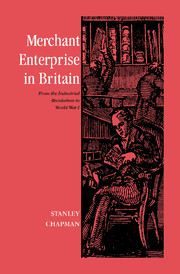Book contents
- Frontmatter
- Contents
- List of figures
- List of tables
- Preface
- Abbreviations used in the footnotes
- Introduction: approaches and concepts
- Part I The setting
- Part II New Streams Of Enterprise
- Chapter 3 Merchants in the Atlantic trade
- Chapter 4 The agency houses: trade to India and the Far East
- Chapter 5 The international houses: the foreign contribution to British mercantile enterprise
- Chapter 6 The home trade houses
- Part III Response to instant communication
- Part IV Conclusions
- Manuscript sources
- Index of firms and people
- Index of places
- Index of subjects
Chapter 4 - The agency houses: trade to India and the Far East
Published online by Cambridge University Press: 20 March 2010
- Frontmatter
- Contents
- List of figures
- List of tables
- Preface
- Abbreviations used in the footnotes
- Introduction: approaches and concepts
- Part I The setting
- Part II New Streams Of Enterprise
- Chapter 3 Merchants in the Atlantic trade
- Chapter 4 The agency houses: trade to India and the Far East
- Chapter 5 The international houses: the foreign contribution to British mercantile enterprise
- Chapter 6 The home trade houses
- Part III Response to instant communication
- Part IV Conclusions
- Manuscript sources
- Index of firms and people
- Index of places
- Index of subjects
Summary
The most far-reaching change in the pattern of British overseas trade in the nineteenth century was the shift from the ‘old’ markets of Europe and North America to the newer markets of Africa, Australia and (above all) the Far East (Tables 0.4, 0.5). Liverpool and Manchester merchants helped to break the East India Company's monopoly of trade to the East but the northern enterprise described in the last chapter was by no means the only or most significant commercial initiative in the subcontinent. The most important development was the evolution of the type of organisation known as the ‘agency houses’, later the ‘managing agency system’. As there has been a good deal of confusion about these organisations, it will clear the path if we define the species at the outset of this chapter.
The name ‘agency house’ originally implied nothing more than an establishment where business was done for another, so it was more or less synonymous with the more common name of ‘commission house’, and most firms in British India started as representatives of domestic merchants or manufacturers. However, the opportunities for making (and losing) fortunes were much greater in the Far East, turnover of firms and partners was high, and from the earliest years a core of strong firms, encouraged by the opportunities opened up by British imperial expansion, used their large capitals to secure a stronger base by local investment. ‘Agency houses’ came to imply this kind of mercantile organisation.
- Type
- Chapter
- Information
- Merchant Enterprise in BritainFrom the Industrial Revolution to World War I, pp. 107 - 128Publisher: Cambridge University PressPrint publication year: 1992

